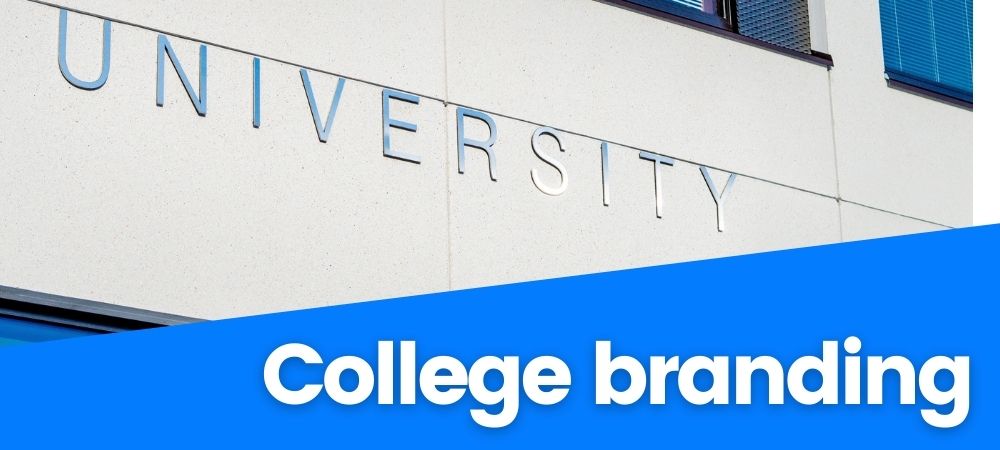Even before the Covid-19 pandemic, student enrollment was declining, down 11% since 2011. In 2020, enrollment dropped 3.5 percent or 603,000 students—a rate seven times higher than the previous year.
To survive, colleges must make a positive impression on students and differentiate their institutions. College branding is key to elevating image—and enrollment.
What is college branding?
College branding is the marketing practice of actively shaping the perception of your school. Institutions use elements like logos, colors, and voice to influence how people experience schools. Perception is also influenced by interactions with stakeholders, both online and in-person.
“Brand is the sum of all the experiences an individual has with an organization, which then helps them determine relevancy”
Tanya Pankratz, Senior Director of Brand and Creative Strategy at Collegis Education
A school’s brand is realized through tangible materials like brochures, web pages, and apparel. Students also experience college branding through more personal encounters, such as:
- Taking a campus tour
- Speaking with admissions officers at a college fair
- Meeting current students or alumni
Aligning your college brand with value
Generation Z, which represents the majority of today’s college students, is passionate about supporting values-based organizations. Gen Z students want to invest in institutions that share their beliefs.
Values-based institutions align brand with their values. For instance, a business school which believes in sustainable business practices might host events, post blog articles, orfeature web testimonials on the topic.
College branding helps tell an institutional story that resonates with students’ belief systems.
“[Gen Z students] are more willing to spend money with companies that reflect their own personal values.”
Tanya Pankratz
As digital natives, students will also invest extra time researching a school’s principles and behavior. A strong brand ensures one cohesive message—and school identity—is shared across media.
College branding can deepen relationships with current students and alumni, as well. A well-developed brand will:
- Elevate school recognition
- Build trust through consistent experiences
- Spark deeper emotional connections
How to build a compelling college brand
1. Integrate mission with messaging
A school’s mission statement and values are the foundation of the brand. The mission establishes the brand’s identity, which guides a school’s strategic messaging.
Take the mission statement for Stratford University, a private institution headquartered in Falls Church, Virginia:
“The mission of Stratford University is to prepare students for rewarding careers through quality educational programs that meet the changing needs of employers and the community.”
Stratford University
Stratford integrates its mission statement into different school and program descriptions on their website. The school of culinary arts’ landing page provides a particularly strong example:

Stratford emphasizes career readiness and advancement—a core tenant of the school’s mission. The description also highlights preparation for evolving demands, harkening the mission’s “changing needs of employers.” Educational quality is underscored through hands-on skills development and tangible improvements.
A school’s mission can drive messaging for other key marketing pieces, including:
- Digital and print advertisements
- Social media copy
- Headlines on posters
- Emails
2. Develop strategic value propositions
A value proposition is a statement that communicates a school’s benefits to a specific audience subset. Value propositions can strengthen college branding by emphasizing a program’s unique offerings—and ensuring messaging is as strategic as possible.
Value propositions are research-based and tailored to students’ needs, interests and preferences. Student personas, which profile different types of students, are a good place to start.
Stratford University’s homepage features several good examples. Check out the three blurbs below, each of which highlight a distinctive program benefit.
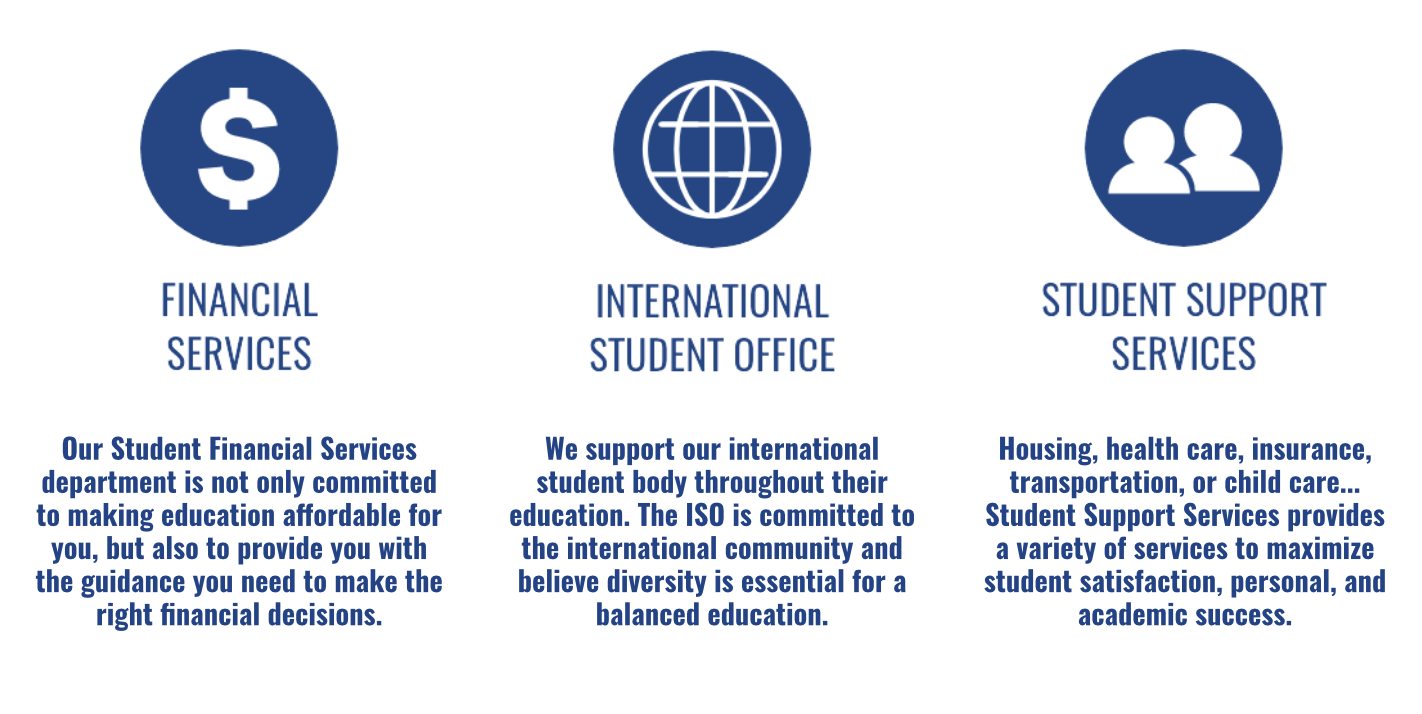
For the financial services department, Stratford emphasizes affordable education and decision empowerment; for the international office, diversity; and for student support, variety of services. Each blurb speaks to different cohort of students, with varying needs and values.
Value propositions can also drive a school’s messaging. Depending on audience, value propositions might shape messages on landing pages, social media posts, brochures, and more.
3. Establish a distinctive voice and tone
A school’s voice and tone also convey the brand’s personality. Voice is how messages are consistently expressed; tone adapts voice to the media, such as social media or email, to convey different attitudes.
A strong, consistent voice helps differentiate the brand and form an impression. Voice and tone can shape a brand by impacting how a school is perceived.
In their online voice and tone guidelines, Boston University (BU) provides a helpful definition and description of voice:
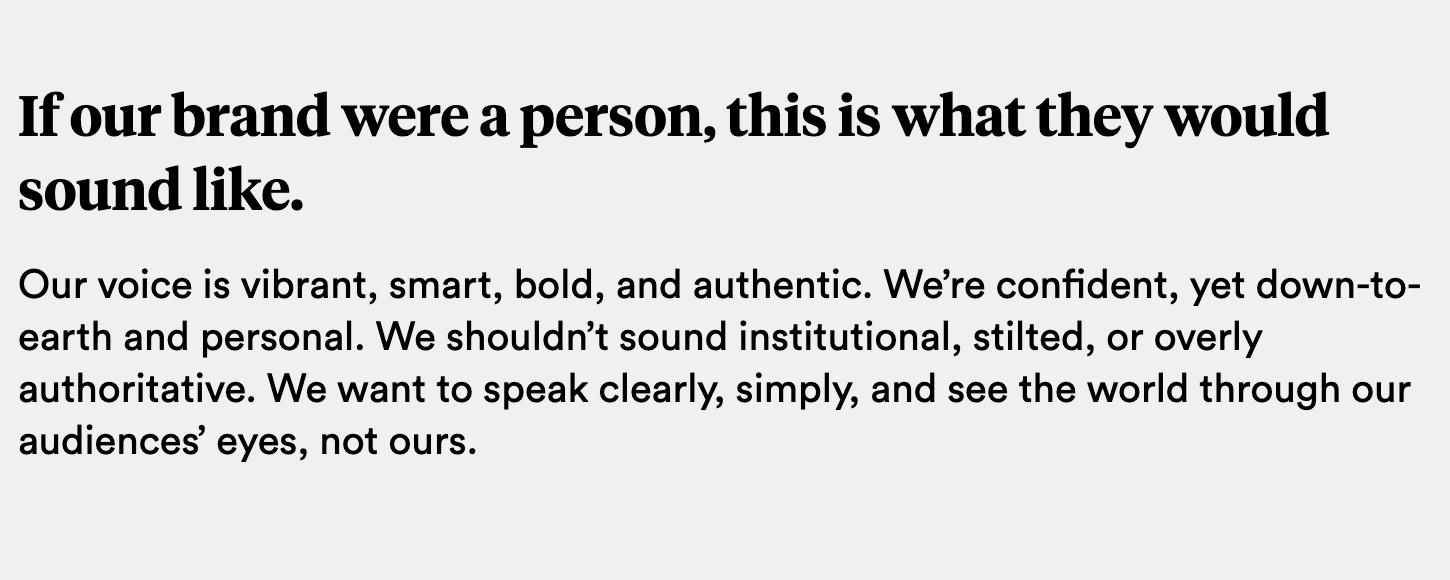
BU’s ad “We Dare You” demonstrates voice and tone in action. The ad is bold, confident, and clear—core elements of the institution’s voice. “We Dare You” is tailored to a specific medium (digital advertisement) with a short, direct statement.
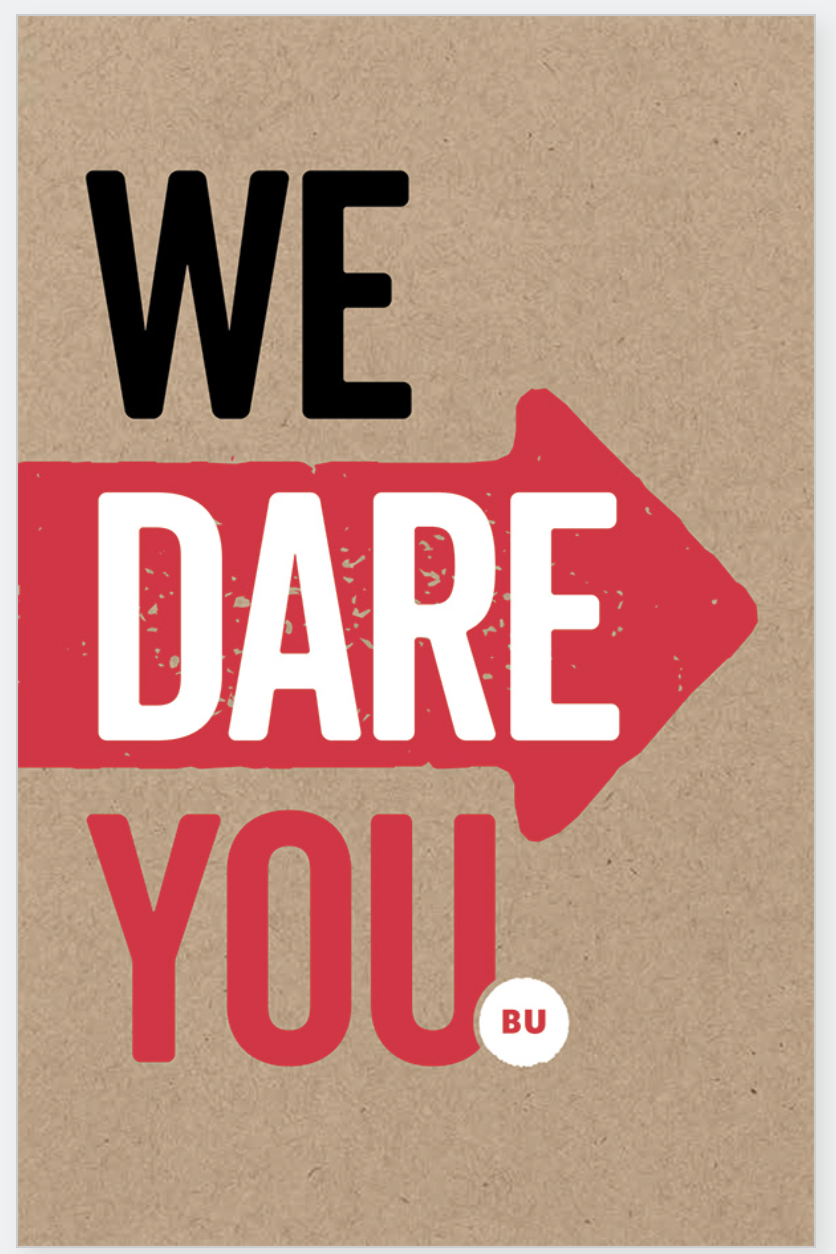
4. Create a strong visual identity
A visual identity is how a brand is represented graphically. Many mistakenly assume visual identity as “the brand,” in and of itself, while it’s merely one component of a larger whole.
Your visual identity combines several graphic elements to tell your brand’s story:
- Logo
- Color palette
- Typography
- Photography
Logo and colors are the foundation of visual identity. Both should reflect overall brand personality and be easy to apply across various media. Typography complements logo and color by determining how text appears graphically.
Tricoci University, a cosmetology school in the Midwest, provides a good example of strong visual identity.

Tricoci’s logo is simple yet distinctive, with a plain graphic positioned above the text. The bright, lime green color grabs attention and adds personality. Tricoci’s typeface is bold yet elegant—a reflection of overall brand identity.
Don’t forget photography.
On-brand photography is especially important, as much of a brand’s story is told through images. Use imagery which demonstrates your brand’s values, and what prospective students will experience. Tricoci’s homepage photo (above) is a good example of on-brand imagery.
Additional photography tips include:
- Use a consistent, cohesive visual style.
- Ensure imagery is high quality and high resolution.
- Be mindful of inclusive representation.
5. Create a comprehensive style guide
Inconsistent experiences and messages undermine the brand’s effectiveness. So, consistency across touchpoints is crucial for college branding.
A college brand style guide helps ensure uniform branding. The style guide provides stakeholders with resources to apply consistent branding practices, such as logos, typeface names, and voice best practices.
In How to create a brand style guide, 99designs charts six essential elements of a brand style guide:

Check out Boston University’s comprehensive brand style guide.
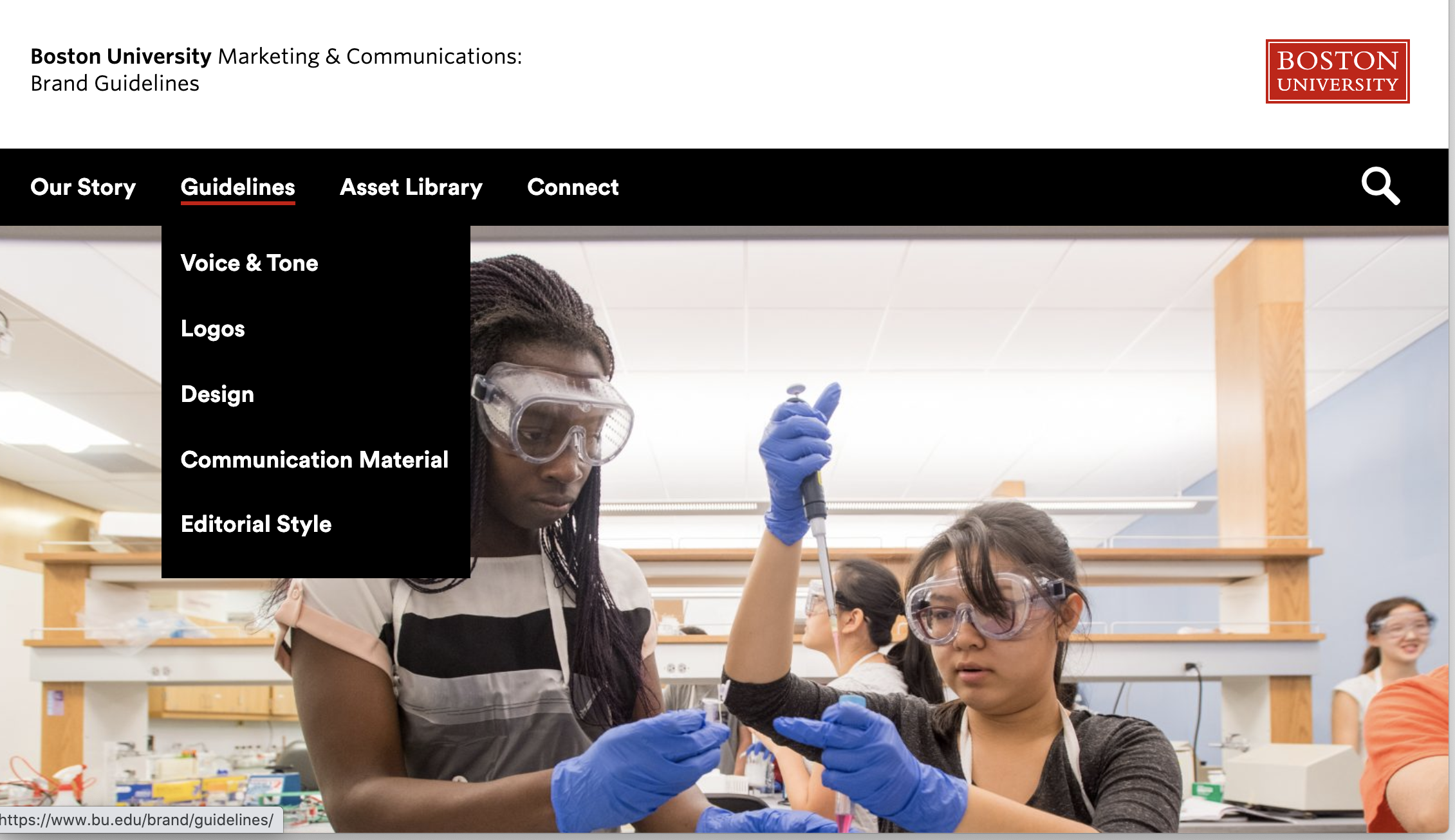
BU’s brand website contains a variety of guides, each outlining how to use a different element of the brand. BU also features an asset library with downloadable logos, photography, fonts and templates. Even the website itself, bu.edu/brand, is branded.
BU also offers Brand 101 workshops, where brand guidelines and examples are presented.
College branding is ever-evolving
Study your competition
After the brand is established, schedule routine content audits to evaluate competitors’ messaging and visual identities. Understanding a peer institution’s approach helps ensure a school remains unique in the marketplace. Research may also spark ideas on how to refine the brand.
Evaluation questions might include:
- What values are they portraying?
- What actions do they take to show those values?
- What kind of experience do they offer?
Research community perceptions
Every several years, consider conducting a deep dive with university partners and key stakeholders to evaluate brand experience. Qualitative data is invaluable for refining brand messaging and personas.
Stakeholders might include faculty, staff, current students or alumni, engaged through:
- Focus groups
- Online surveys
- One-on-one discussions
- Polls via social media or email
Depending on the stakeholder, research areas might include:
- What inspired enrollment
- Current institutional challenges
- Student outcomes
Keep building your brand
College branding is an evolving process. To maintain a strong and relevant brand, schools should continuously evaluate stakeholder perceptions. Keep an eye on internal changes, like leadership transitions or new strategic goals, and how these might affect the brand.
College branding is a powerful tool schools can use to communicate their identity. Brands differentiate schools in the marketplace through strategic messaging, visual identity, and personal interactions. With schools vying for fewer students—and undergraduates seeking values-based institutions—a strong brand is essential to enrollment success.





